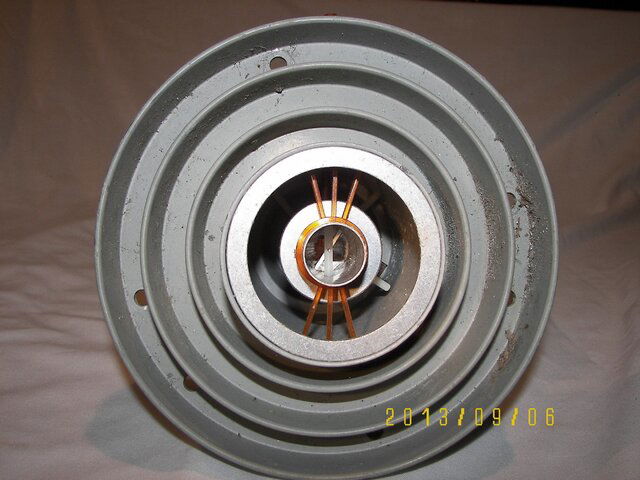I have a chaparral feed horn that has weird stuff in it. I thought when I got it that it was to receive circular polarities with big dish LNBs. You can see the fixed amber butterfly in the C area. Also see the white plastic rod that moves as skew is changed. In the KU section there looks like a metal butterfly that fans out as skew is changed. On the side there are two white screws that appear to center the main stalk. For the KU there are two adjustment screws 180 out that move an amber screw thingy back and forth. I forget where I got it but it had an old Gardiner KU LNB on it. Anybody seen anything like this? I am thinking it is a Corotor II Plus Wideband or Corotor II Plus. Also wondering if the fluffy corrosion inside will affect satellite signals. This fall I want to change to a 10 foot Winegard dish I picked up and figure I'll throw this feed horn on.
Name that feed horn
- Thread starter buduglie
- Start date
- Latest activity Latest activity:
- Replies 5
- Views 3K
You are using an out of date browser. It may not display this or other websites correctly.
You should upgrade or use an alternative browser.
You should upgrade or use an alternative browser.
- Status
- Please reply by conversation.
Some thing to remember about many of the 10 foot Winegards dishs (I have two model 1088) is they are of deeper design. Some of the early single output feedhorns were of fixed scaler position so the "golden ring" was made to extend the length of the feedhorn throat. A little "fuzz" probably not a real issue in the input waveguide area. I have a very vintage Califorina Amp C/Ku feedhorn but I keep it on the shelf next to my LNA collection. I am worried that old sat equipment might only receive the old tv programs like I Love Lucy or Rin Tin Tin.
My older Cal Amp dual feed is much like your picture in that the Ku section is near the front of the waveguide throat. My unit is way past its prime days and a bit beat up around the Ku section. Good luck with your unit.
My older Cal Amp dual feed is much like your picture in that the Ku section is near the front of the waveguide throat. My unit is way past its prime days and a bit beat up around the Ku section. Good luck with your unit.
Last edited:
I used to have a Chaparral Ku only feed that looked just like the Ku section of your feed. It had a sort of serrated ribbon that was fixed at the bottom end of the throat, where it fed into the LNB. The other end rotated to match the polarization of the satellite. I think it had a donut shaped magnet around the outside of the throat to rotate the ribbon, causing it to twist. But its been about 30 years, so my memory is probably a little fuzzy on the details.
It is definitely for linear, not circular polarization.
It is definitely for linear, not circular polarization.
That is a Corotor C/Ku feedhorn. You need a polarity control to switch H ~ V and set skew. Also a switch, like a 22khz tone switch to select the C or Ku LNB. Actually not a bad setup for a big C-Band dish. There is a manual for one in the FTA downloads section (HTS Tracker Twin)
I have one of those feeds.
Will check back with the member who gave it to me for more info.
The one thing I do recall, is that it's too big in diameter to fit into a regular scalar.
You must use the custom scalar that came with it.
Will check back with the member who gave it to me for more info.
The one thing I do recall, is that it's too big in diameter to fit into a regular scalar.
You must use the custom scalar that came with it.
Yes. But put it on the dish and see how well it works before attempting cleaning it out. Can't really tell in the pictures how bad it is. Might be just minimal attenuation.fluffy corrosion inside will affect satellite signals.
GE had a problem with their (aluminum) helical resonators in some models of two way radios back in the 80's. If the 'fuzzies' grew large enough it really de-tuned the things. The 'Fix' was gentle sanding smooth, then applying some stuff to 'neutralize' the aluminum and 'fix it' so it wouldn't grow back. Did the 'Fix' to around 70 radios. Danged if I can remember what that 'stuff' was. All my search terms return nothing that's related. Maybe someone else remembers?????
I do remember GE calling them 'hairs' of aluminum oxide.
- Status
- Please reply by conversation.
Similar threads
- Replies
- 0
- Views
- 71
- Replies
- 8
- Views
- 1K
- Replies
- 1
- Views
- 357
- Replies
- 0
- Views
- 487
- Replies
- 9
- Views
- 1K



